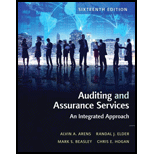
Auditing and Assurance Services (16th Edition)
16th Edition
ISBN: 9780134065823
Author: Alvin A. Arens, Randal J. Elder, Mark S. Beasley, Chris E. Hogan
Publisher: PEARSON
expand_more
expand_more
format_list_bulleted
Question
Chapter 15, Problem 31DQP
a.
To determine
Compute the TER- SER using non-statistical sampling and also determine whether or not the computed allowance sampling risk is sufficient to accept the population.
b.
To determine
Compute the CUER by using the attribute sampling.
c.
To determine
Identify the effect of Computer Upper Exception Rate (CUER) while changing each factor and keeping the other factors constant.
d.
To determine
Identify the factors that have a great and lowest effect on CUER by comparing them with requirement a, b and c.
e.
To determine
Explain the necessity of comparing CUER with Tolerable Exception Rate (TER).
Expert Solution & Answer
Want to see the full answer?
Check out a sample textbook solution
Students have asked these similar questions
Sample Size Determination. Review each of the following independent sets of conditions.Required:Use AICPA sample size tables to identify the appropriate sample size for use in a statistical sampling application (ROO = risk of overreliance, EPDR = expected population deviation rate, TRD = tolerable rate of deviation). What is your conclusion regarding the relationship of each of these factors to sample size based on comparing the sample sizes across differentcombinations of these factors?a. ROO = 5%, EPDR = 0%, TRD = 7%.b. ROO = 5%, EPDR = 3%, TRD = 7%.c. ROO = 5%, EPDR = 3%, TRD = 6%.d. ROO = 10%, EPDR = 0%, TRD = 7%.
Sample Size Determination. Review each of the following independent sets of conditions.Required:Use AICPA sample size tables to identify the appropriate sample size for use in a statisticalsampling application (ROO = risk of overreliance, EPDR = expected population deviationrate, TRD = tolerable rate of deviation). What is your conclusion regarding the relationshipof each of these factors to sample size based on comparing the sample sizes across differentcombinations of these factors?a. ROO = 5%, EPDR = 1%, TRD = 4%.b. ROO = 5%, EPDR = 1.5%, TRD = 4%.c. ROO = 5%, EPDR = 1.5%, TRD = 6%.d. ROO = 10%, EPDR = 1.5%, TRD = 4%
When using sampling in the study of internal control, the audit team would compare theupper limit rate of deviation to thea. Expected population deviation rate.b. Sample rate of deviation.c. Statistical rate of deviation.d. Tolerable rate of deviation
Chapter 15 Solutions
Auditing and Assurance Services (16th Edition)
Ch. 15 - Prob. 1RQCh. 15 - Prob. 2RQCh. 15 - Prob. 3RQCh. 15 - Prob. 4RQCh. 15 - Prob. 5RQCh. 15 - Prob. 6RQCh. 15 - Prob. 7RQCh. 15 - Prob. 8RQCh. 15 - Prob. 9RQCh. 15 - Prob. 10RQ
Ch. 15 - Prob. 11RQCh. 15 - Prob. 12RQCh. 15 - Prob. 13RQCh. 15 - Distinguish between the TER and the CUER. How is...Ch. 15 - Prob. 15RQCh. 15 - Prob. 16RQCh. 15 - Prob. 17RQCh. 15 - Prob. 18RQCh. 15 - Prob. 19RQCh. 15 - Prob. 20RQCh. 15 - Prob. 21RQCh. 15 - Prob. 22.1MCQCh. 15 - Prob. 22.2MCQCh. 15 - Prob. 22.3MCQCh. 15 - Prob. 23.1MCQCh. 15 - Prob. 23.2MCQCh. 15 - Prob. 23.3MCQCh. 15 - Prob. 24.1MCQCh. 15 - Prob. 24.2MCQCh. 15 - Prob. 24.3MCQCh. 15 - Prob. 25.1MCQCh. 15 - Prob. 25.2MCQCh. 15 - Prob. 25.3MCQCh. 15 - Prob. 27DQPCh. 15 - Lenter Supply Company is a medium-sized...Ch. 15 - Prob. 29DQPCh. 15 - Prob. 30DQPCh. 15 - Prob. 31DQPCh. 15 - Prob. 32DQPCh. 15 - Prob. 33DQPCh. 15 - Prob. 34DQPCh. 15 - Prob. 35DQPCh. 15 - Prob. 36CCh. 15 - Prob. 37ICA
Knowledge Booster
Similar questions
- Consider a sample with data values of 10, 20, 12, 17, and 16. a. Compute the mean and median. b. Consider a sample with data values 10, 20, 12, 17, 16, and 12. How would you expect the mean and median for these sample data to compare to the mean and median for part a (higher, lower, or the same)? Compute the mean and median for the sample data 10, 20, 12, 17, 16, and 12.arrow_forwardWhich of the following steps involved with determining the upper limit on misstatements is ordinarily performed earliest?a. Multiply the sampling interval by the tainting percentage.b. Determine the audited value of the item and compare it to the recorded balance.c. Calculate the basic allowance for sampling risk.d. Calculate the incremental allowance for sampling risk.arrow_forwardThe risk that the decision made based on the sample will differ from the decision madebased on the entire population is referred to asa. Audit risk.b. Examination risk.c. Sampling risk.d. Nonsampling riskarrow_forward
arrow_back_ios
arrow_forward_ios
Recommended textbooks for you
 Auditing: A Risk Based-Approach (MindTap Course L...AccountingISBN:9781337619455Author:Karla M Johnstone, Audrey A. Gramling, Larry E. RittenbergPublisher:Cengage Learning
Auditing: A Risk Based-Approach (MindTap Course L...AccountingISBN:9781337619455Author:Karla M Johnstone, Audrey A. Gramling, Larry E. RittenbergPublisher:Cengage Learning Essentials of Business Analytics (MindTap Course ...StatisticsISBN:9781305627734Author:Jeffrey D. Camm, James J. Cochran, Michael J. Fry, Jeffrey W. Ohlmann, David R. AndersonPublisher:Cengage Learning
Essentials of Business Analytics (MindTap Course ...StatisticsISBN:9781305627734Author:Jeffrey D. Camm, James J. Cochran, Michael J. Fry, Jeffrey W. Ohlmann, David R. AndersonPublisher:Cengage Learning

Auditing: A Risk Based-Approach (MindTap Course L...
Accounting
ISBN:9781337619455
Author:Karla M Johnstone, Audrey A. Gramling, Larry E. Rittenberg
Publisher:Cengage Learning

Essentials of Business Analytics (MindTap Course ...
Statistics
ISBN:9781305627734
Author:Jeffrey D. Camm, James J. Cochran, Michael J. Fry, Jeffrey W. Ohlmann, David R. Anderson
Publisher:Cengage Learning